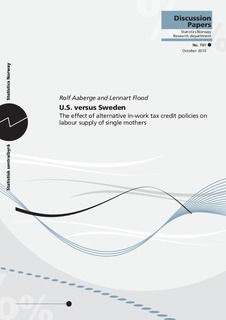| dc.contributor.author | Aaberge, Rolf | |
| dc.contributor.author | Flood, Lennart | |
| dc.coverage.spatial | Sweden, USA | nb_NO |
| dc.date.accessioned | 2019-11-12T10:10:42Z | |
| dc.date.available | 2019-11-12T10:10:42Z | |
| dc.date.issued | 2013-10 | |
| dc.identifier.issn | 0809-733X | |
| dc.identifier.uri | http://hdl.handle.net/11250/2627892 | |
| dc.description.abstract | An essential difference between the design of the Swedish and the US in-work tax credit systems relates to their functional forms. Where the US earned income tax credit (EITC) is phased out and favours low and medium earnings, the Swedish system is not phased out and offers 17 and 7 per cent tax credit for low and medium low incomes and a lump-sum tax deduction equal to approximately 2300 USD for medium and higher incomes. The purpose of this paper is to evaluate the efficiency and distributional effects of these two alternative tax credit designs. We pay particular attention to labour market exclusion; i.e. individuals within as well as outside the labour force are included in the analysis. To highlight the importance of the joint effects from the tax and the benefit systems it appears particular relevant to analyse the labour supply behaviour of single mothers. To this end, we estimate a structural random utility model of labour supply and welfare participation. The model accounts for heterogeneity in consumption-leisure preferences as well as for heterogeneity and constraints in job opportunities. The results of the evaluation show that the Swedish system without phase-out generates substantial larger labour supply responses than the US version of the tax credit. Due to increased labour supply and decline in welfare participation we find that the Swedish reform is self-financing for single mothers, whereas a 10 per cent deficit follows from the adapted EITC version used in this study. However, where income inequality rises modestly under the Swedish tax credit system, the US version with phase-out leads to a significant reduction in the income inequality. | nb_NO |
| dc.description.sponsorship | Norwegian Council of Research Stiftelsen Riksbankens Jubileumsfond Söderbergs stiftelser | nb_NO |
| dc.language.iso | eng | nb_NO |
| dc.publisher | Statistisk sentralbyrå | nb_NO |
| dc.relation.ispartofseries | Discussion papers;761 | |
| dc.subject | JEL classification: I38 | nb_NO |
| dc.subject | JEL classification: J22 | nb_NO |
| dc.title | U.S. versus Sweden. The effect of alternative in-work tax credit policies on labour supply of single mothers | nb_NO |
| dc.type | Working paper | nb_NO |
| dc.description.version | publishedVersion | nb_NO |
| dc.subject.nsi | VDP::Matematikk og Naturvitenskap: 400::Matematikk: 410::Statistikk: 412 | nb_NO |
| dc.source.pagenumber | 41 | nb_NO |
